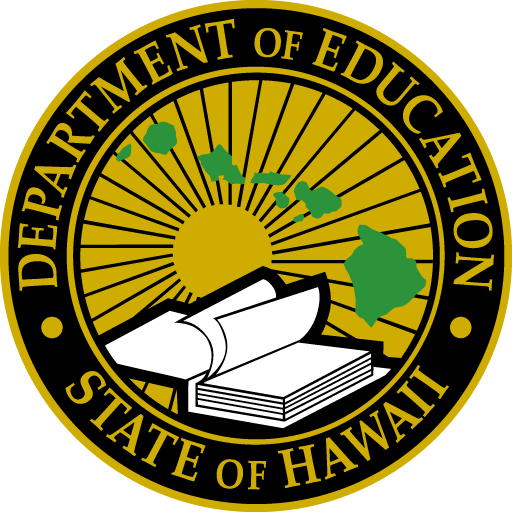Hawaiʻi’s public school 健康指南 promote student and staff well-being through policies on health education, nutrition, physical activity and professional development.
wellness in our public schools
指南
“Wellness” in our public schools includes a wellness committee, 營養 指引、健康教育、營養促進、體育教育、體育活動和員工專業發展。這 健康指南 實施教育委員會 政策 103-1(PDF) 並滿足要求 公法 108-265 第 204 條 (PDF) 和 健康飢餓兒童法案(2010).
現有譯本:
Wellness Committee
All of our schools have a designated wellness coordinator and a committee that meets at least three times per year to address school health issues, including the implementation of the 健康指南. The wellness committee should consist of school administration, faculty and staff, as well as students, families and community representatives. The committee is responsible using data sources (e.g., Youth Risk Behavior Survey) to identify priority areas for the school’s Academic Plan.
At the beginning of each school year, each school community is notified about the wellness policy and provided with the wellness coordinator’s contact information. The schools also encourage students’ families to support wellness at school and at home.
有關您如何參與的更多資訊:
Nutrition 指南
與從家裡帶午餐的學生相比,吃學校午餐的孩子更有可能食用牛奶、肉類、穀物和蔬菜。他們也往往攝取更多的營養——無論是午餐還是一整天。我們的首要任務是確保學生獲得營養餐,為學習和體育活動提供能量。該部門在學年期間每天提供超過100,000份餐點。詳細了解 營養 指引.
學校促進良好營養的方法:
- 校園裡展示了有關營養食品的正面訊息。
- 供學生使用的自動販賣機只售有水。
- 學校餐點盡可能從零開始製作,包括新鮮出爐的全麥麵包。
- 沒有食物含有反式脂肪。
- 用餐期間,學生可以免費獲得飲用水。
- 歡迎各班參觀食堂廚房,學習如何準備健康食品。
- 向學生及其家長推廣健康的早餐、午餐和點心。
- 教學花園展示了食物是如何生長的。
健康教育和營養促進
健康教育 and nutrition promotion provide the instructional foundation that is necessary to prepare students to make lifelong healthy decisions and practice healthy behaviors. This component area of the 健康指南 包括在全校推廣營養餐和零食以及優質的健康教育。
指南 for health education and nutrition promotion are organized around 四個關鍵組成部分:
- 健康教育課程的教學內容重點在於支持健康飲食的知識和技能,並與 HIDOE 健康教育標準保持一致。
- 小學學生每週接受健康教育時間不少於45分鐘,中學學生每週接受健康教育時間不少於200分鐘。
- 營養教育包括以文化為基礎、親自動手的文化相關活動,例如食物準備、品嚐、參觀農場和學校花園。
- 所有學校食品和飲料行銷必須符合 營養 指引。這包括但不限於學校出版物、自動販賣機外部、海報、橫幅、校內電視和記分板。
體育
目標 體育 (體育)的目的是幫助所有學生獲得終身從事體育活動所需的知識、技能和信心。參與體育鍛煉還可以幫助學生達到國家建議的每天 60 分鐘的體育活動量。
There are six 指引 to support PE:
- 體育課的教學內容與夏威夷教育部體育標準一致。
- 小學學生每週至少接受45分鐘體育教育,中學學生每週至少接受200分鐘體育教育。
- 體育課的時間中至少有 50% 用於中度到劇烈的體力活動。
- 體育課均由國家認證的體育教練授課。
- 體育課的師生比與其他課程相似。
- 5、7 和 9 年級的體育教育包括與健康相關的學生體能評估(例如 FitnessGram)。
體力活動
定期的體力活動可以強健骨骼和肌肉,提高肌肉力量和耐力,降低慢性病的風險,提高自尊心,減輕壓力和焦慮。研究還表明,體育活動有助於提高學生的學業成績,包括成績和標準化考試分數。
There are six 指引 to support physical activity:
- 學生每天有至少 20 分鐘的休息時間,其中包括進行中度到劇烈的體育活動的機會。
- 每 60 分鐘至少提供學生一次體育活動休息時間。
- 學校不會將體育活動(例如課間休息或體育課)作為負面後果。
- 學校支持主動交通,鼓勵學生和教職員工在安全的情況下步行和/或騎自行車上學。
- 學校為學生和教職員工提供自行車架。
- 學校工作人員、學生、家長和社區成員可以在非教學時間(即課前、課後、週末和假日)進入校園並利用學校設施進行體育活動。
專業發展
In order to create a school community that is supportive of wellness, school staff are provided with opportunities for professional development relating to wellness. There are two 指引 支持專業發展:
- School staff receive annual professional development on the 健康指南.
- School staff are encouraged to be role models for wellness.
資源
- 健康指南 (PDF)
- 健康指南 Resource for Schools (需要 HIDOE 工作人員登入)
Local Wellness Policy Assessment
每三年評估一次
美國農業部(USDA) Final Rule: Local School Wellness Policy Implementation Under the HHFKA of 2010 requires all local educational agencies (LEAs) to establish the minimum requirements for local wellness policies and complete the 每三年評估一次 (PDF)適用於所有參加全國學校午餐計畫和/或學校早餐計畫的學校。
每三年,評估必須確定:
- Compliance with the wellness policy.
- How the wellness policy compares to model wellness policies.
- Progress made in attaining the goals of the wellness policy.
查看評估。
- 每三年評估一次 2022 年 7 月 (PDF)
- Triennial Assessment July, 2025 (PDF)
Safety and Wellness Survey (SAWS)
This annual online survey of public school principals is used to monitor and evaluate schools’ progress toward implementing the 健康指南. It is jointly administered by the Department of Education and Department of Health. Key indicators from the SAWS are included in the HIDOE’s annual report. View the latest Safety and Wellness Survey (PDF) 結果。
- Safety and Wellness Survey: 2023-24 (PDF)
- Safety and Wellness Survey: 2022-23 (PDF)
- Safety and Wellness Survey: 2021-22 (PDF)
美國農業部非歧視聲明
根據聯邦民權法和美國農業部 (USDA) 民權法規和政策,本機構禁止基於種族、膚色、國籍、性別(包括性別認同和性取向)、殘疾、年齡或對先前民權活動的報復或報復而進行歧視。
該計劃的資訊可能以英語以外的其他語言提供。需要其他溝通方式(如點字、大字印刷本、錄音帶、美國手語)獲取計劃資訊的殘疾人士,應聯繫負責管理該計劃的州或地方機構,或致電美國農業部 TARGET 中心(電話:(202) 720-2600(語音和 TTY),或透過聯邦中繼服務(電話:(800) 87777-39)聯繫美國農業部。
要提出項目歧視投訴,投訴人應填寫表格 AD-3027(美國農業部項目歧視投訴表),該表格可從以下網址在線獲取: https://www.usda.gov/sites/default/files/documents/USDA-OASCR%20P-Complaint-Form-0508-0002-508-11-28-17Fax2Mail.pdf如需協助,可從任何美國農業部辦事處獲取,可致電 (866) 632-9992,或寫信給美國農業部。信函中必須包含投訴人的姓名、地址、電話號碼以及涉嫌歧視行為的書面描述,其詳細程度足以告知民權事務助理部長 (ASCR) 涉嫌侵犯民權的性質和日期。填妥的 AD-3027 表格或信函必須透過以下方式提交給美國農業部:
- 郵件:
美國農業部
民權事務助理部長辦公室
西南獨立大道 1400 號
華盛頓特區 20250-9410;或者 - 傳真:
(833)256-1665 或(202)690-7442;或者 - 電子郵件:
[email protected]
該機構是一個平等機會提供者。
